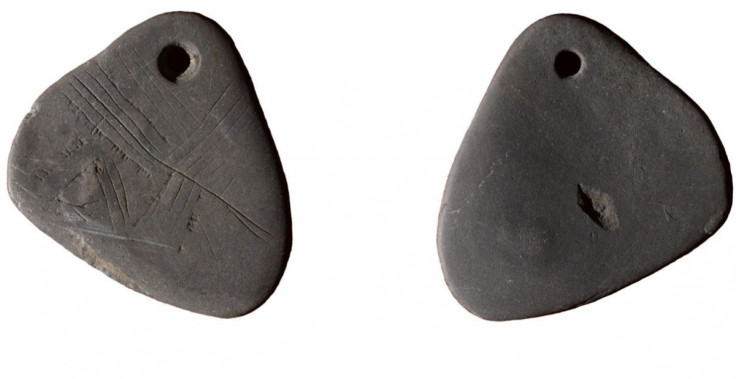11,000-year-old pendant with mysterious engravings found in North Yorkshire

Archaeologists have discovered an 11,000-year-old engraved pendant, thought to be the earliest known Mesolithic art in Britain. The pendant bears engravings that are yet to be deciphered, researchers said.
The research team from the Universities of York, Manchester and Chester found the pendant during excavations at the Early Mesolithic site at Star Carr in North Yorkshire. The artwork is made of shale, crafted from a single piece.
The sub-triangular pendant measures 31mm by 35mm in size and is three millimetres thick. A series of lines which archaeologists believe may represent a tree, a map, a leaf or even tally marks, is engraved on one side of the artefact.
"Engraved motifs on Mesolithic pendants are extremely rare and no other engraved pendants made of shale are known in Europe," the researchers said in a statement, adding that the pendant was examined to know if it had been strung or worn and whether pigments had been used to make the lines more prominent.
"It was incredibly exciting to discover such a rare object. It is unlike anything we have found in Britain from this period," lead researcher, Professor Nicky Milner, of the Department of Archaeology at York, said. "We can only imagine who owned it, how they wore it and what the engravings actually meant to them."
Milner said the pendant might have belonged to a witch doctor as headdresses made out of red deer antlers found nearby in earlier excavations are thought to have been worn by them. "We can only guess what the engravings mean but engraved amber pendants found in Denmark have been interpreted as amulets used for spiritual personal protection," she said.
According to Dr Chantal Conneller from the University of Manchester and co-director of the excavations, the pendant represents close cultural connection among northern Europeans as the engravings are similar to those found in southern Scandinavia.
Scholars hope that the find will add to their understanding of the rituals, beliefs and cultural values of the people who lived in Yorkshire 11,000 years ago. They were also the first permanent settlers of Britain after the last Ice Age and the pendant depicts about their art, researchers noted.
"This is something that a person wore, that had significance to them and to the people around them," Dr Barry Taylor, excavation co-director from the University of Chester, said.
The pendant has been put on display for public viewing at the Yorkshire Museum in York along with other Star Carr finds including flints, a rare barbed point used for hunting or fishing and 11,000-year-old fire lighters. All the artefacts were found in "amazingly" preserved conditions.
© Copyright IBTimes 2025. All rights reserved.






















